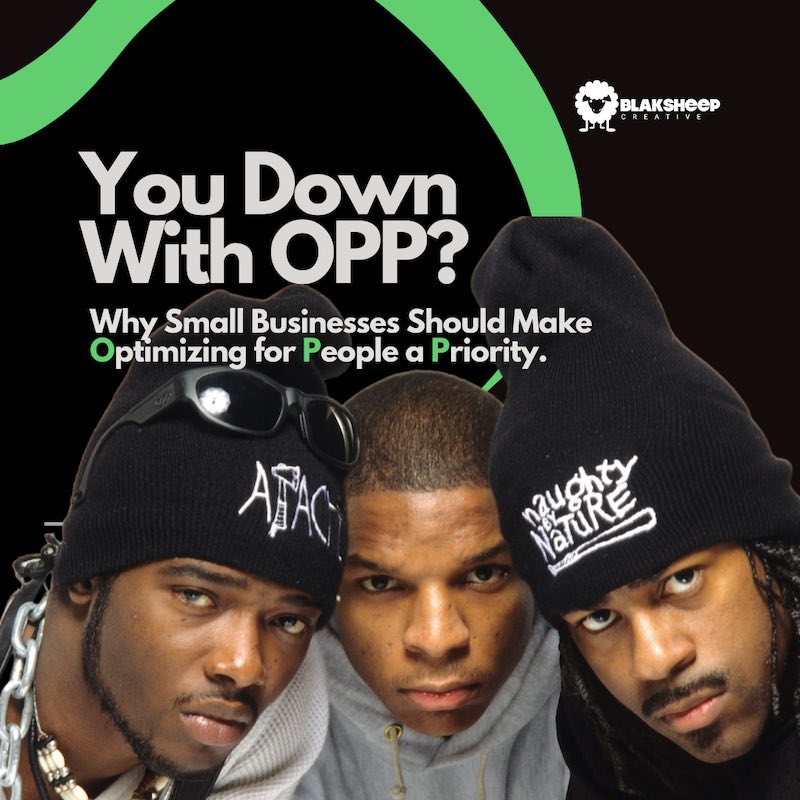“Muffler shops near me,” “Muffler Shop Baton Rouge, Louisiana,” “Muffler Installation Baton Rouge Cost.”
If you’ve ever searched on Google, chances are pretty good that you’ve used a variation of one (or all) of the above phrases. And if you own a small business with a website, there’s a good chance you’ve tried to optimize your site for these kinds of searches, too.
Does that sound like it’s written for people or for search engines?
Since we’ve gotten the song in your head, here’s a video you can play to have a little background music while you’re reading:
We see it all the time.. amateur SEOs who think they can game the system by cramming in as many keywords as possible, regardless of how it sounds to actual human beings.
But here’s the thing: search engines are constantly changing their algorithms, and what might work today could be useless tomorrow. So why bother optimizing for them at all?
The answer is simple: because people still use them.
A 2017 study by SEMRush looked closely at 600,000 keyword phrases and how they rank on Google. The results revealed that 18% of sites ranked in position 20 or higher on Google had no keywords in the text.
In other words, 82% of sites that rank on the first page of Google are there not because of some secret keyword formula but because they’re just plain good.
They’re informative, well-written, and valuable to those searching for them.
So if you’re a small business owner trying to optimize your site for search engines, take a step back and ask yourself: am I writing this for a person or a machine?
Chances are, if you’re writing for a person, the search engines will take care of themselves.
Write for people first and search engines second:
This one may sound like a no-brainer, but you’d be surprised how many small business owners write their website content with search engines rather than people in mind.
It’s an amateur SEO mistake that can cost you dearly in the long run.
Why?
My reaction going to a landing page stuffed with a wall of irrelevant content & littered with typos. This is keyword stuffing and should be categorized as black hat SEO. Designed for robots rather than designed for humans, totally missed the point, the page won’t convert! #seo pic.twitter.com/5OnUDhUe5J
— Adam Sturrock (@AJSturrock) June 10, 2020
Because it reads like a robot wrote it.
It’s full of keyword stuffing, awkward phrases, and choppy sentences. It’s dry, dull, and about as interesting as watching paint dry.
In other words, it’s the opposite of what people actually want to read.
What’s more, if you’re writing for search engines rather than people, you’re likely missing out on a huge opportunity to connect with your potential customers on a more personal level.
Think about it: when someone comes to your site, they’re not just looking for information. They’re looking for a solution to a problem or an answer to a question.
If you can provide that, you’ll not only earn their trust but their business as well.
So next time you’re writing content for your site, remember to keep the following in mind:
1. Write for people first, and search engines second.
We’ve already established that people are your primary audience, so make sure your content is geared towards them first and foremost.
Use natural language that’s easy to read and understand, and avoid keyword stuffing at all costs. Not only will it make your content more enjoyable to read, but it’ll also help you rank higher in search engines.
2. Make sure your web content is informative, well-written, and useful.
No one wants to read a fluff piece full of nothing but empty words. If you want people to read your content, make sure it’s informative, well-written, and useful to them.
Bloody awesome #blog post telling it like it is on #Worlddownsyndromeday2021. There’s enough fluff in the world anyway. Heartfelt words are where it’s at. https://t.co/sqrDqOSEXt
— Dr C (Rachel) 💙 (@DrColeFletch) March 21, 2021
3. Connect with your audience on a personal level.
Your website is the perfect opportunity to connect with potential customers on a more personal level. Take advantage of that by writing your content in a way that’s relatable and easy to understand.
3. Focus on solving a problem or answering a question.
Remember, people come to your site looking for a solution to a problem or an answer to a question. If you can provide that, you’ll not only earn their trust but their business as well.
4. Keep it short and sweet.
People have short attention spans, so make sure your content is brief and to the point. Get straight to the point, and avoid fluff or filler.
In other words, don’t just create content to get all of the target keywords in. Not only will it make your content less enjoyable to read, but it could also get you penalized by Google.
5. Use subheadings, bullet points, and images.
No one wants to read a massive wall of text. Breaking up your content with subheadings, bullet points, and images will make reading more enjoyable and help you rank higher in search engines.
6. Promote your content.
Just because you’ve published a piece of content doesn’t mean people will automatically find it. You need to promote your content if you want people to actually see it.

The best way to do that is to share it on social media and in forums, groups, and other online communities. By promoting your content, you’re increasing its chances of being seen and read by potential customers.
7. Use Google Analytics to track your results.
Google Analytics is a free tool that allows you to track how much traffic your content is getting and where that traffic is coming from.

This is important because it allows you to see what’s working and what’s not to adjust your content accordingly.
8. Regularly update your content.
Your content should be evergreen, meaning it should be relevant and useful even months or years after publishing it. But that doesn’t mean you shouldn’t update it regularly.
Whenever there’s new information to be added or old information that needs to be updated, make sure to do so. This will not only keep your content relevant, but it’ll also help you rank higher in search engines.
What Not to Do
Now that we’ve gone over what you should do, it’s time to look at what you shouldn’t do. Just as there are certain things you can do to make sure your content is successful, there are also certain things you should avoid if you want people to actually read it.
Here are a few things to keep in mind:
1. Don’t just create content for the sake of creating content.
Why should people read your content if you’re not providing value or solving a problem? Make sure whatever you’re writing is worth reading before you hit publish.
After all, the internet is already full of information. Yours needs to be worth reading if you want people to take the time to read it.
2. Don’t keyword stuff.
We’ve already touched on this, but it’s worth repeating. Keyword stuffing is when you stuff your content full of keywords to get picked up by search engines. Not only will this make your content less enjoyable to read, but it could also get you penalized by Google.
3. Don’t plagiarize.
This should go without saying, but it’s still worth mentioning. Plagiarism is copying someone else’s work and passing it off as your own. Not only is this unethical, but it’s also illegal.
If caught plagiarizing, you could face some serious consequences, including a lawsuit. So it’s just not worth it.
4. Don’t use too many affiliate links.
Affiliate links are links to products or services for which you’re an affiliate. You’ll earn a commission if someone clicks on one of your affiliate links and makes a purchase.
While there’s nothing wrong with using affiliate links, you shouldn’t use too many of them. If your content is filled with nothing but affiliate links, people will quickly lose interest and move on.
5. Don’t forget to proofread.

Nothing will make people lose interest in your content faster than spelling and grammar errors. Before you hit publish, proofread your content and fix any mistakes.
You can also run it through a tool like Grammarly to catch any errors you might have missed.
Now let’s flip the script.
What if we told you that sometimes keep search engines in mind when writing?
It’s true!
When it’s OK to write with search engines in mind.
There are certain types of content where it pays to be aware of how search engines work.
This includes things like:

Meta descriptions
Meta descriptions are the brief descriptions that appear under your title in a search engine.
While they don’t directly affect your ranking, they are essential because they can help you stand out from the competition and entice people to click on your link.
This is why it’s important to make sure your meta descriptions are well-written and keyword-rich.

Titles and headings
The title of your article and the headings within it are also important. This is because they give people an idea of what your content is about and help them decide whether or not it’s worth reading.
Unlike meta descriptions, title tags and headings do have an impact on your ranking. This is why it’s important to make sure they’re well-written and keyword-rich.
But there’s a catch: simply stuffing keywords into your titles and headings won’t do the trick. It’s about finding that perfect balance where your content not only ranks well but also genuinely connects with your readers.
For a masterclass in striking this balance and ensuring your titles and headings are doing the heavy lifting they’re meant to, delve into our detailed exploration, “Is Your Website Stuck in the Past? ‘Home’ in SERPs is No Laughing Matter.” Discover how to transform your website from being just another result in the SERPs to the result that users click on.
URLs
Your URL is also important for both people and search engines. A good URL is short, descriptive, and easy to read. It should also include keywords, if possible.
For example, a good URL for an article about SEO tips would be something like:
https://blaksheepcreative.com/services/digital-marketing/
A bad URL, on the other hand, would be something like:
https://blaksheepcreative.com/12345 (not a real link)
As you can see, the first URL is much better because it’s short, descriptive, and includes a keyword.

Alt text
Alt text (or alternative text) is the text that appears when an image doesn’t load. It’s also what people with visual impairments using screen readers “see” when they’re reading your content.
It’s also an important ranking factor.
Search engines want everyone to have the best user experience possible.
This is because search engines can’t see images (although they’re making great strides in this area), so they rely on alt-text to understand what an image is about.
This is why it’s important to make sure your alt text is well-written and keyword-rich.
But here’s where it gets tricky.
Technically, your alt-text should describe the image for those unable to see it. However, you also want to make sure it’s keyword-rich so that it can help you rank.
This can be a difficult balance to strike, but it’s important to try.
For example:
Suppose you have an image of a dog. You want to (if at all possible without getting too creative) make sure that your alt text includes the keyword “dog.”
At the same time, you also want to make sure it’s a good description of the image. So, if you’re trying to rank for “labrador retriever,” your alt text might be something like:
“A chocolate labrador retriever playing fetch.”
This is a good alt text because it’s both keyword-rich and descriptive.
When you add alt text to your images, you’re not only helping those who are unable to see them, but you’re also helping your SEO.

Internal Linking
Last but not least is internal linking. Internal linking is when you link to other articles on your website from within another one.
This is important because it helps search engines understand your website and can also help people find more of your content.
It’s also a great way to keep people on your website longer, improving your ranking.
Your anchor text is also important. This is the text that people see when they’re reading your article.
You want to make sure your anchor text is descriptive and keyword-rich. For example, if you’re linking to an article about SEO tips, your anchor text might be something like: “For more SEO tips, check out this article.”
But never, ever, ever, opt for “click here” as your anchor text.
Another amateur mistake!
Not only is it not keyword-rich or descriptive, but it also doesn’t give people an idea of what they will find if they click on the link.
So when you’re creating content for your website, keep search engines in mind:
- How they travel from one page to another – By providing links to other pages on your site, you’re making it easy for them to do this.
- How your internal pages push link juice to your main pages – By linking to your main (or money) pages from your inner pages, you’re giving them a boost.
By thinking like a search engine in your linking strategy, you’re giving your website a better chance of ranking higher in the search results.
Final Thoughts
While it’s important to keep search engines in mind when creating content for your website, it’s even more important to write for people first and foremost.
This is because, at the end of the day, people will be reading your content, not search engines.
And if you’re not writing for people, then you’re not going to get the traffic or engagement you’re looking for.
So before you start writing your next blog post or article, ask yourself: Who is my audience? What do they want to read? And how can I give them what they’re looking for?
If you can answer these questions, then you’re well on your way to creating content that both people and search engines will love.
If you’re looking for top-notch copywriting and content marketing, look no further than BlakSheep Creative.
We are digital marketing experts with years of experience in the industry and know how to create all kinds of content that will engage your audience and help you rank higher in search engines. Contact us today for a free consultation or visit our copywriting page to learn more about our services:
















































